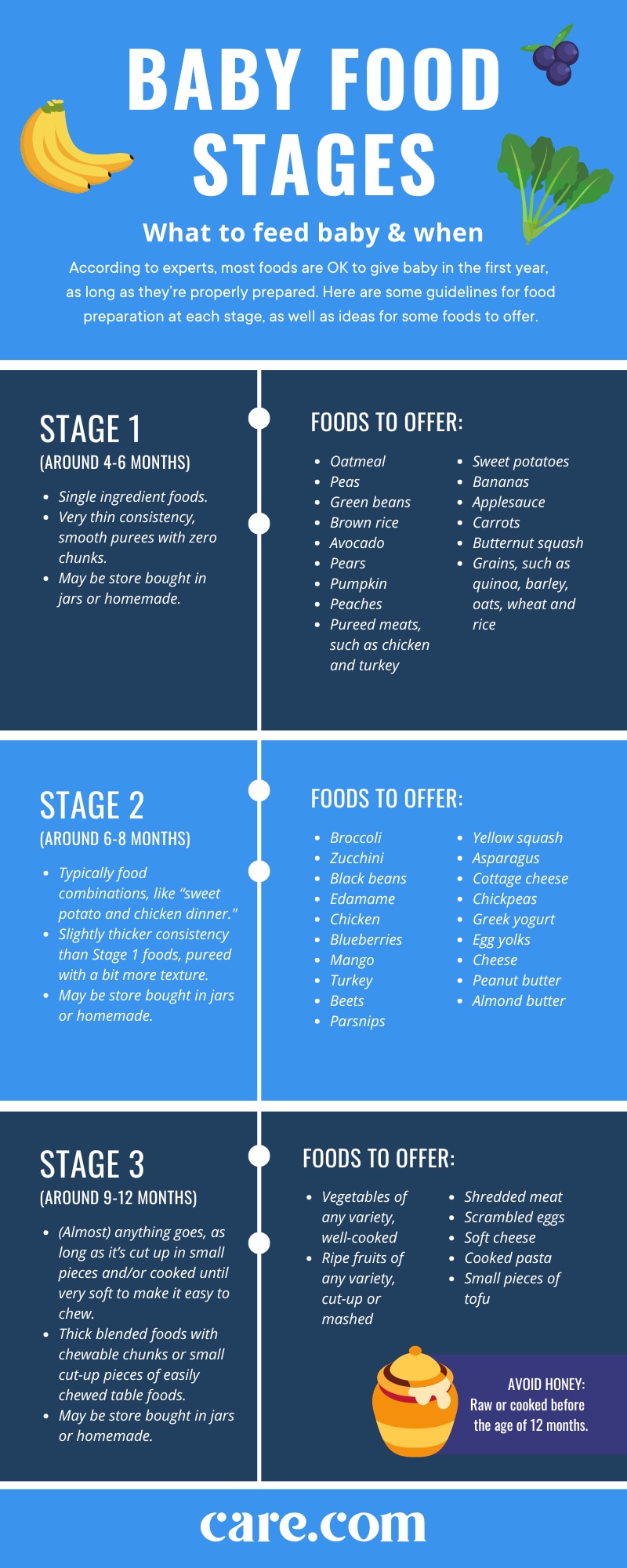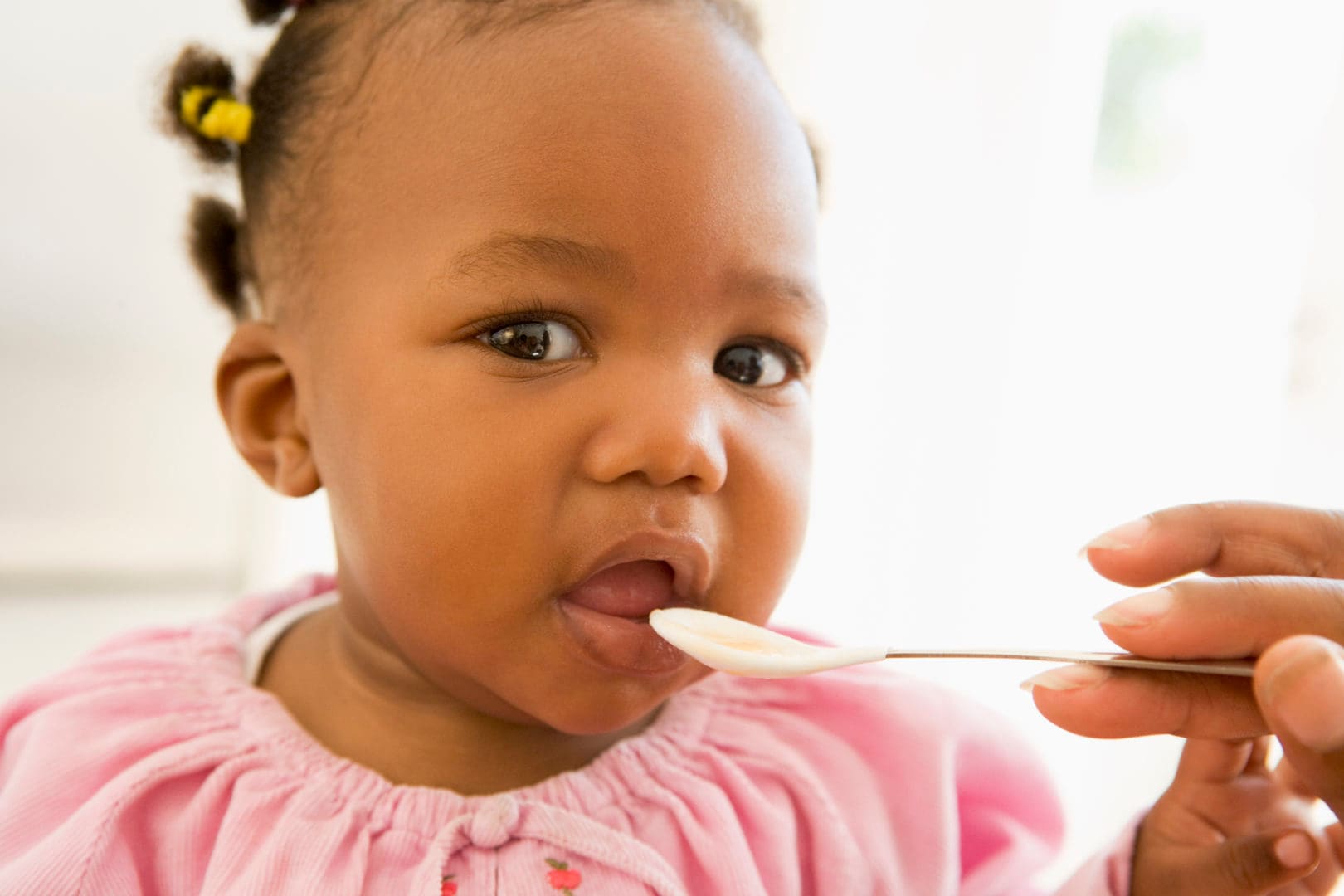Once your baby has mastered the art of slurping down smooth purees, it may be time to expand their culinary horizons with Stage 2 baby food. Your little gourmand isn’t quite ready to dine on a plate of spaghetti and meatballs just yet, but Stage 2 foods will give them the opportunity to sample new tastes, as well as consistencies.
Think your baby is ready to graduate onto the next stage of baby food? Here, parents and experts weigh in on Stage 2 baby food. Bon appetit!
What is Stage 2 baby food?
While the jarred Stage 2 baby food you find at the store is typically combinations of food (“sweet potato and chicken dinner”), it’s important to keep in mind this stage is more about the consistency of the food.
“While Stage 1 baby food is completely pureed, Stage 2 baby food has a bit more texture to it,” says Dr. Zulma Laracuente, a pediatrician in Alexandria, Louisiana. “The concept behind slowly transitioning baby from purees to thicker solids is to get them used to chewing and swallowing.”
Of course, every child develops at their own individual pace, so check with your child’s doctor for baby food recommendations during the first 12 months.
When to start Stage 2 infant food
The Stage 2 baby food age may vary based on when your infant started eating Stage 1 foods. The general age recommendation for Stage 1 baby food is between 4 and 6 months, so taking into consideration how long — and how well — your child has been eating these foods will help you determine if they’re ready to move up. According to Laracuente, babies are usually ready for Stage 2 between 6 and 8 months old — but make sure your little one has honed their Stage 1 skills before making the leap.
“Once your baby has done well with Stage 1 solids and has tried multiple foods, it is safe to advance to Stage 2 baby food,” says Dr. Melanie Custer, a pediatrician at at West Bend Pediatrics at Children’s Hospital of Wisconsin. “These foods usually have multiple ingredients, including some spices and are thicker in consistency.”
“These foods usually have multiple ingredients, including some spices and are thicker in consistency.”
— Dr. Melanie Custer, pediatrician
Signs baby is ready to start Stage 2 food
How do you know if your baby is nailing it with their Stage 1 foods and ready for the next step? Simply put, they’re eating and swallowing.
“As your baby’s oral skills develop and improve, you can move on to Stage 2 foods, which are purees with small chunks and texture,” says Jenifer Thompson, R.D., an advanced practice dietician at Johns Hopkins in Baltimore.
Thompson says in order to move on to Stage 2 foods, babies should be consistently taking the spoon in their mouth when you offer it to them, without spitting or pushing it back out.

“Once my baby was no longer grimacing or letting his food dribble onto his chin, I knew we were ready to move onto Stage 2 foods,” says mom of two Darcy McConnell of Garwood, New Jersey. “I actually have no idea how old he was when we made the switch since I based it off of how well he was eating!”
What Stage 2 baby foods to start with
It’s important to expose your child to a number of foods, most of which are safe at this point.
“By the time they are 7 to 8 months, babies should be eating a variety of foods from different food groups, including cereals, meat and other proteins, yogurt, cheese, vegetables and fruits,” says Thompson.
“Most foods can be prepared for any stage, so long as they’re texturally age-appropriate,” says Dr. Kristen Treegoob, a pediatrician at Children’s Hospital of Philadelphia. “When we think of Stage 2 baby food, we’re thinking of thicker purees with some mashable bits.”
Experts advise introducing as many different foods as possible during this stage of food development so your baby gets accustomed to them.
“While bananas, applesauce and peaches are good options and most babies like them, as they are naturally sweet, it is also important to try other foods that aren’t as common and popular, such as beets, rhubarb and asparagus, so they develop a taste for them,” says Custer.
Another thing to keep in mind is that the American Academy of Pediatrics (AAP) no longer recommends delaying the introduction of allergenic foods, particularly peanuts. While it was once advised to wait until your baby was at least 10 months to introduce peanut-containing foods, the AAP now recommends giving babies with no known egg allergy or eczema, infant-safe forms of peanut between 4 to 6 months old. Babies with mild eczema should wait until at least 6 months, and for babies with severe eczema, speak to their doctor before giving them peanut-containing foods. (To find out if your baby has an egg allergy, they must be tested by their pediatrician.)
Which foods to avoid during Stage 2
Even though your little one is venturing into new food texture territory with Stage 2, you should still avoid giving them chunks and small pieces of food, which can pose a serious risk. (Food may be thicker at Stage 2, but it’s still all about the purees and mashes at this point.)
“Infants may have any food that is texture-appropriate for their developmental feeding stage, but it’s important to stay away from choking hazards, such as whole grapes, nuts and seeds,” says Treegoob.
“Infants may have any food that is texture-appropriate for their developmental feeding stage, but it’s important to stay away from choking hazards, such as whole grapes, nuts and seeds.”
— Dr. Kristen Treegoob, pediatrician
Also, avoid giving your baby honey — raw or cooked — before the age of 12 months, as it may cause a botulism infection.
And finally, when it comes to your baby’s beverage, steer clear of juice. The AAP recommends parents eschew juice, which has “no nutritional benefits over whole fruit,” until at least 1. “At this point, it’s best to stick with breast milk, formula or the odd bit of water (1 to 2 ounces a day), which is mainly for introducing your baby to the skill of using a sippy cup,” says Thompson.
How to start Stage 2 foods safely
Baby should be sitting in a highchair when eating and never left alone. You’ll still be spooning food into your baby’s mouth at this point, but don’t be afraid to let your little one take a whirl at self-feeding in order to get in some practice using utensils.
“At around 9 months, we started letting our son try his hand at feeding himself in his highchair,” says mom of two Erin Henderson, of Waltham, Massachusetts. “It was a mess, but he obviously enjoyed the learning experience.”
Also, during the latter half of your baby’s Stage 2 stint, they may learn how to grab things with their thumb and forefinger and bring them to their mouth.
“Between 8 and 12 months, babies develop the pincer grasp ability and should be able to pick up small pieces of finger food, such as Cheerios or puffs,” says Thompson.
As your baby grows and hones their eating skills, they’ll cut down a bit on how much breast milk or formula they drink — but keep in mind, that should still be their primary source of nutrients.
“Most infants will naturally start to moderate their breast milk or formula intake once their solid intake increases,” says Treegoob. “Solid food may start to account for a significant source of nutritional intake closer to 7 to 9 months. At this time, parents may notice that their baby shows interest in smaller or less frequent bottle or breastfeeds. As long as their weight remains on track and baby is drinking enough milk to stay well-hydrated, there should be no need for concern. Infants typically take somewhere between 24 to 40 ounces of breast milk or formula between 4 to 6 months and 24 to 32 ounces from 6 to 9 months.”
According to the AAP, babies should be eating about 4 ounces of solids (about one small jar of baby food) at each of their meals. And if you’re wondering how long baby food lasts, experts typically recommend 24-48 hours in the fridge or up to 3 months in the freezer.
Lastly, bear in mind that if at first you don’t succeed with a food, try, try again.
“At this age, if babies grimace when taking a bite or shake themselves, it is most often because of a texture issue, not the actual taste,” says Custer. “It is important to keep introducing these foods as it may take a baby up to 15 times to get used to a texture before you can say for sure he/she doesn’t like it.”
Ready for the next stage?
Here is our guide for stage 3 baby food.




